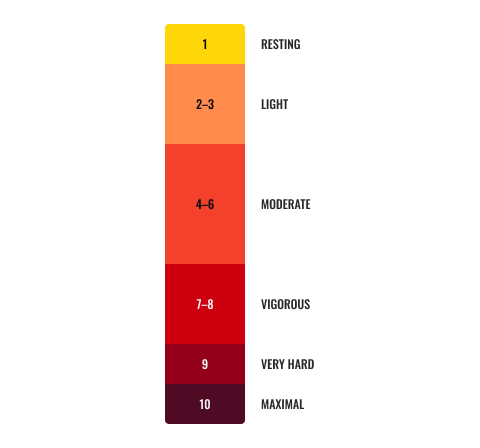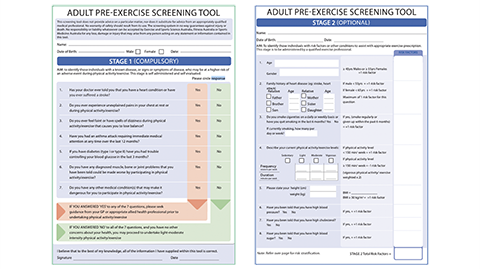In this topic, we focus on the need and importance of pre-screening along with your responsibilities as a personal trainer and how the information you collect should be used in the process of program design. You will learn:
- The importance of pre-screening
- Pre-screening and goal setting tools
- ACSM risk factor stratification.
Terminology and vocabulary reference guide
As an allied health professional, you need to be familiar with terms associated with basic exercise principles and use the terms correctly (and confidently) with clients, your colleagues, and other allied health professionals. You will be introduced to many terms and definitions. Add any unfamiliar terms to your own vocabulary reference guide.
Activities
There are several practical activities in the topic and an end of topic automated quiz. These are not part of your assessment but will provide practical experience that will help you in your work and help you prepare for your formal assessment.

Your responsibilities as a personal trainer
Being a personal trainer carries a responsibility to ensure that the information you are providing is accurate and appropriate for each individual, with the safety of your client and other members of the gym at the core of all you do.
Remember you will work with a wide range of people from different backgrounds. Within the general population you will interact and work with people who may include:
- People of all ages, including senior citizens
- People of all genders
- People from different cultural, language and social backgrounds
- People who may have limited English language, literacy, and numeracy skills
- People with disabilities (including sight, hearing, mobility, intellectual).
This means that a personal trainer must not discriminate on the basis of ethnicity, culture, impairment, language, age, gender, sexual preference, religion, political beliefs, or status in society. It also means adjusting a programme and your communication skills when appropriate. You must demonstrate an awareness of culturally appropriate practices when interacting with a client. New Zealand is culturally diverse and practices may vary depending on the cultural background of your client.
You need to observe clients carefully as they perform each exercise, monitor their HR (heart rate), and RPE (rated perceived exertion) using an RPE scale which measures the intensity of the exercise. The scale runs from 0 - 10. Safety needs to be at the forefront of your mind at all times!
As a fitness professional, it is important to give your client the tools they need to exercise safely and effectively both in your presence and when they train independently. One key tool is known as the perceived rate of exertion, often referred to as PRE (or RPE- rate of perceived exertion) or the Borg scale. This tool is a subjective tool in which your client can let you know how they feel during training but rating themselves on a scale of typically, 1-10 (you will also see scales which range from 6-20, these are used in the same fashion as 1-10 scales).
When working with your client, you can use extra information they provide you such as how they appear, are they flushed in the cheeks are they are able to speak in full or part sentences, to gauge their PRE appropriately. Use the following scale to help both you and your client determine how hard they are training. This tool is useful for general population clients also however is of particular use when working with special population clients.

Perceived rate of exertion
1: Resting
- No exertion e.g. sitting, watching TV
2-3: Light activity
- Minimal exertion – feels like it can be maintained for hours.
- Easy to breathe and carry on a conversation e.g. household chores.
4-6: Moderate activity
- Feels like you can exercise for hours.
- Breathing heavily. Can hold a conversation, but sentences become shorter.
7-8: Vigorous activity
- On the verge of becoming uncomfortable
- Short of breath, can speak a short sentence
9: Very hard activity
- Very difficult to maintain the set exercise intensity
- Can barely breathe and speak in short, aggravated, words.
10: Maximal activity
- Feeling almost impossible to keep going
- Completely out of breath, unable to talk.
The consultation is an opportunity for a personal trainer or coach to get to know the client better and figure out their values, beliefs, and goals. The best way to gather the client's background information is by asking open-ended and closed questions.
- What objectives do you have?
- How do you feel about beginning this fitness journey?
- What type of exercise activities do you enjoy?
- What are your top three goals?
- Is increasing your muscles your key objective?
- Have you ever attended a gym before?
- Do you have any physical conditions that affect you using weights or other equipment?
- Have you ever used a rowing machine?
Open and closed questions help you to:
- gather detailed medical and exercise history
- create specific and measurable goals
- determine any weaknesses/barriers to exercises.
Documentation
You will be required by your gym to complete documentation recording the consultation. These are sometimes called screening forms. Each gym will have its own paperwork and processes for recording and filing the records. Confidentiality and client privacy is important so make sure any completed paperwork is stored safely.
Look at the REPS Pre-screening form which is approved by the New Zealand Register of Exercise Professionals. You can see it has the following sections:
- Important medical information,
- A diagram to label areas of the body that may be adversely affected by exercise
- Programming information including exercise goals, exercise history, client availability
- Monitoring progression
- Proposed schedule.
You may wish to download this document for future reference and explore more of the REPs has to offer at the NZ Register of Exercise Professionals website.

Pre-screening implies a preliminary step taken in order to identify any potential risks of the reason for exclusion when undertaking an exercise routine, similar to a job interview in the sense you would be asked a series of questions to determine if you are the right candidate for the role. Within exercise, you would pre-screen your client to determine:
- If your client is medically and physically safe to exercise and if so, further determine the appropriate intensity and other variables within the FITT principle
- If medical referral and or clearance is required
- If you are a suitable professional to safely, and effectively, meet their medical and exercise needs.
It is important to provide an initial screening of all participants in order to determine risk factors and or disease limitations prior to embarking on an exercise routine. This is to ensure the safety of the clients during exercise testing and to effectively contribute towards as suitable, sustainable, and safe exercise program.
Pre-screening is a two-way process, in the sense that, you should use this stage to determine not only if your client is a suitable candidate for exercise but also if the needs of your client falls within your scope of practice, i.e. are you qualified to safely guide them through their exercise needs. If not, do not be a hero, ask for further advice from your gym manager, a more experienced personal trainer or refer to an allied health professional such as a G.P or Exercise Physiologist for more medically comprehensive screening and exercise supervision.
All health and fitness professionals conduct a pre-screening session to:
- optimise safety
- develop sound and effective exercise prescription
- identify individuals with disease symptoms and risk factors for disease development who should receive medical clearance before starting an exercise program
- identify and exclude individuals with medical contraindications to exercise
- identify individuals with other special needs.

Obtaining accurate client information and provide appropriate exercise prescription is of upmost importance for all clients, this will put you in the best possible position to significantly reduce both the likelihood and severity of causing a serious incident or injury as a result of your professional advice. It is recommended that client screening is conducted as an essential component of all exercise prescription and, can often be of significant support during any legal cases surrounding concerns regarding personal injury possibly sustained during an exercise session or program design, should such situations arise.
A sound and approved method for gathering this information would be to include the Physical Activity Readiness Questionnaire (PAR-Q) in your pre-screening session. This questionnaire, created by British Columbia Ministry of Health and the Multidisciplinary Board and Exercise, adopted directly from the American College of Sports Medicine (ACSM) Standards and Guidelines for Health and Fitness Facilities, contains relevant questions in the necessary detail for you to be able to determine if your client is medically fit to exercise and any parameters you may need to work around when planning and conducting your exercise program together. The key focus of this questionnaire is to identify the small number of adults for whom physical activity might be inappropriate or those who should seek medical advice concerning the most suitable type of activity.
What should be captured in a pre-screening form?
You may find that health and fitness providers adapt the format of the questionnaire to suit their needs, however, the underlying key information is still contained within. The PAR-Q for your use should, at a minimum, must contain the following:
- Medical history questions – injury, disease, or condition (past or present) and medications
- Questions that allow you to judge “risk stratification”
- Medical clearance- should risk stratification require medical clearance
- Lifestyle evaluation – diet, recreational activities, exercise history (and current), availability, personal commitments etc.
- Things that can also be included:
- Informed consent and commitment statement (signed)
- Exercise and Biometric testing – baseline data.
Let us look further into some of these components.
Medical history
You should require your clients to complete a comprehensive medical history questionnaire that includes questions concerning personal and family health history. When reviewing medical history, you should carefully focus on conditions that require medical referral. If any of these conditions are noted, refer your client to their GP for medical clearance prior to exercise testing or starting an exercise program.
Important – keep a copy of this in your client file, confidentially, for your own records to refer to.
Medication
It is also important to note the types of medication being used by the client and to ascertain what effects (if any) these will have on their ability to train. Drugs such as digitalis, beta-blockers, diuretics, vasodilators, bronchodilators, and insulin may alter the individual’s heart rate blood pressure, ECG, and exercise capacity, you should be aware of these and incorporate this knowledge into your program and progression approach.
If your client reports a medical condition or drug that is unfamiliar to you, make sure you consult medical references or a GP to obtain more information before conducting any exercise tests or allowing the client to participate in an exercise program.
Lifestyle evaluation
Planning a well-rounded fitness program for a client requires that you to first find out information about their living habits. The lifestyle assessment provides useful information regarding the individual’s risk factor profile.
Factors such as smoking, lack of physical activity, and diets high in saturated fats or cholesterol increase the risk of CVD and hypertension and therefore increase the risk of participation in vigorous activity. These may also have an effect on blood pressure readings, perceived rate of exertion or lung capacity resulting in exercise being more demanding on these clients.
The lifestyle evaluation component should also gather information on drug and alcohol use, past and present physical activity levels along with the psychological stress levels of the individual. These factors can be used to pinpoint patterns and habits that need modification and to assess the likelihood of the client’s adherence to the exercise program.
It is also useful to know the client's weekly schedule in terms of work and other commitments so you know what you will have to be working around, for example, understanding they work 5 days a week and have only weekends available will enable you to design a program that suits their weekend availability. Exercise type and location preferences are also worth noting as these will aid you in making the program engaging and achievable for your clients.

Goals and motivations
It is important to find out why the client has decided to embark on an exercise programme now, is there a specific event they wish to train for? Are they working towards achieving their goals by a particular date such as a birthday, anniversary or wedding day?

Discuss your client’s goals and record them following the SMARTER process. Click on each of the following components to learn more.
Goals need to be specific, if a client wishes to improve their upper body strength for example, it would make little sense to have cycling as a main focus in their program. Goals need to be designed with an objective in mind, something to aim for.
Some handy questions to ask your client (or have them ask themselves):
- What do I want to achieve?
- Is anyone else involved/needed to achieve success?
- What challenges may I face when working to achieve my goals?
Goals need to be measurable, what is the benchmark of success? Work together with your client to decide how their goals will be measured. For example, they may choose to lose 10kg, run 5km 10 seconds faster than they currently do, be able to master a pull-up or being able to perform 10 squats before becoming fatigued. Whatever their goal is, it needs to have a benchmark, a goal without a benchmark is not a goal, it is also not a healthy goal. Without having a line in the sand which marks success, your client will likely feel lost, unsuccessful and a sense of lack of achievement, this is not beneficial for the phycological state nor their adherence to both their fitness regime and likely their sessions with you.
Some handy questions to ask your client (or have them ask themselves):
- What do you want to achieve and by when- what is your timeline?
- How will you know when you have accomplished your goal?
Goals should be achievable, is the goal realistic, a goal which requires hard work and dedication is fabulous however a goal that is out of realistically out of reach would likely set your client back in terms of confidence and possibly also adherence to their program. As an exercise professional, it is your role to support your clients in goal setting and guide them through this process along with using your knowledge and expertise to help them achieve their fitness goals. If a client should set an unrealistic goal, guide them to support them to reframe it so success can still be achieved, perhaps just a little differently.
Some handy questions to ask your client (or have them ask themselves):
- Is this goal realistic?
- Can you identify any factors which may prevent you from achieving this goal?
Goals need to be relevant, every goal should have a reason, a “why” behind it. “Just cause” goals are never that compelling to achieve.
Some handy questions to ask your client (or have them ask themselves):
- Why am I choosing this goal?
Every goal should have a time point against it, when do you want to achieve this goal. It may be in time for a birthday, anniversary, holiday, wedding day, new years or perhaps before your client starts a new job. Whatever the time stamp, be sure to work with your client to set a date to achieve their goal. Having a goal which is up in the air with no real deadline for achievement creates a weak unstructured goal, setting your client up for a feeling of failure or lack of accomplishment.
Some handy questions to ask your client (or have them ask themselves):
- When do I want to achieve this?
Goal setting is not a one time task, chances are things may change and you may even realise that a goal requires a little tweaking along the way, for example, perhaps smaller steps are required to achieve the goal than first planned for, perhaps some of the FITT principles need to change along the way due to lifestyle adjustments, such as school holidays or changing of work hours means less time available for training for a period of time. Goals and the steps initially planned to achieve these should be evaluated through the journey in order to make any necessary adjustments to ensure your client is best set up on the path to goal success.
Some handy questions to ask your client (or have them ask themselves):
- Are my goals still SMART goals?
- Have any factors within or out with my fitness routine change since I first set my goals?
As a result of the evaluation process, make any necessary adjustments along the way. This does not mean failure or lack of skill for your client, it is simply smart goal planning with the determination to continue to strive to achieve success. Success has never been stated as being easy however, you and your client can work together to overcome any hurdles along the way and achieve their goals with both pride and success.
Some handy questions to ask your client (or have them ask themselves):
- Do I need to make any adjustments in order to continue the path to achieving my goals?
- What adjustments do I need to make?
- What adjustments can I make?
Informed consent
Prior to conducting any physical fitness tests or exercise programs, you should see that each participant signs an informed consent. This form explains the purpose and nature of each physical fitness test, any inherent risks in the testing, and the expected benefits of the tests, client awareness and consent are essential.
Important- If your client is underage (under 18 years of age), a parent or guardian must also sign the informed consent.
Consultation with other professionals
It is not possible for you to know every facet of every condition, or the effects that exercise will have on each condition, therefore you need to ensure that you consult with the medical professionals involved with your client. Remember each client will have different needs and goals (so no blanket approach).
Like you would for any client, consider the type, duration, intensity, frequency, and progression of exercises that are appropriate.

When working with clients, you will need to ensure you consult with the medical professional(s) involved with your client in order to ensure you are aware of all relevant details and that they too are aware of their exercise routine such as adherence to training and any possible issues or factor which may arise during training which their allied health professional may need to be aware of, collaboration is key! You should be particularly aware of the FITT principles in these instances, exercise type, duration, frequency, and intensity are of extreme importance in these situations.
Who is ACSM and why stratify clients?
The American College of Sports Medicine (ACSM) is an association, 50,000 members strong from 90 countries around the globe. They represent 70 occupations within the field of sports medicine field ranging from academics, students, personal trainers, physicians, scientists and health and fitness professionals. Their mission is to “integrate scientific research to provide practical applications of exercise science and sports medicine.” With this in mind, ACSM provides many Golden Standard tools which are used by members of the health and fitness industry worldwide.
In terms of care of general and special population clients, ACSM provides guidelines for stratifying clients (placing into relevant groups or categories) before exercise testing and prescription. Correct stratification requires knowledge of the client's risk factors, some of which may be unavailable to the practitioner. ACMS has produced a Risk Stratification Chart which should be used as a guideline, in order to enable fitness professionals to correctly classify special population clients before training.
ACSM risk stratification
The process of stratification involves determining the presence of any previously diagnosed condition or disease, evaluating the total number of risk factors, and, considering the presence of any signs or symptoms which may suggest possible conditions or disease. As a result, the client will fall into one of the following three categories:
- Low risk: Males 45 years or under/females 55 years or under who have no major symptoms and no more than one risk factor.
- Medium risk: Males older than 45 years and female over 55 years who exhibit two or more risk factors.
- High risk: Males older than 45 years and female over 55 years who exhibit one or more symptoms or have known cardiovascular, pulmonary, or metabolic conditions (e.g. Type 2 diabetes).
Risk factors and symptoms
A risk factor is something which increases an individual’s likelihood of adverse effects, (in this case we are referring to adverse effects of exercise), it could do so by inducing certain symptoms. For example, a smoker would typically be more likely to be short of breath as a result of exercising than a non-smoker. Take a look at the list below which categorises some of these risks and symptoms. It is important as an exercise professional to have a strong awareness of these and design and adapt programs and sessions where applicable in order to maintain safety and duty of care in regards to your client's participation and medical status both during and after training.
Risk factors
- Known metabolic disease – cancer, type 2 diabetes, dementia etc.
- Systolic blood pressure (Sys BP) over 140mmHg or diastolic over 90mmHg (referred to as high blood pressure)
- Total serum cholesterol over 200 mg/dL, or LDL over 130 mg/dL, HDL over 40 mg/dL or taking medication for cholesterol
- Waist over 40 inches/100cm girth(males), 35 inches/ 76 cm (females)
- Cigarette smoker or has quit in the last 6 months
- Heart attack, bypass surgery or sudden death before age 55 in father or another male first-degree relative/sudden death before age 65 in mother or another female first-degree relative
- BMI over 30
- Pregnant (inc.1 or more of the 6 contra-indications)
- Not participating in at least 30 minutes of moderate physical activity (which makes you sweat) at least three days a week for the last 3 months or more.
Symptoms with exercise
- Shortness of breath
- Chest pain
- Dizziness
- Heart murmur
Risk factors and stratification
Most people can be safely evaluated and commence an exercise program, however, through an effective risk stratification process, some clients are identified as unsafe to commence exercising as the risk for such clients outweigh the benefits of exercising. Risk stratifying will split clients into two categories:
- Absolute contra-indications
- Relative contra-indications
Absolute contra-indications
Absolute contra-indications apply to those which exercise testing should not be performed until the situation or condition has stabilised.
Examples of absolute contra-indications include:
- Recent significant change in ECG suggesting infarction or another acute cardiac event
- Recent complicated myocardial infarction – heart attack
- Recent systemic or pulmonary embolus – blockage by a small particle in the blood
- Uncontrolled ventricular dysrhythmia – heart rhythm dysfunction
- Severe aortic stenosis – narrowing of the aorta
- Active or suspected myocarditis (inflammation of the heart) or pericarditis
- Unstable angina (blockage of an artery)
- Third-degree heart block (atrium contracts but is not followed by the ventricle)
- Acute congestive heart failure (the heart can not pump enough blood to the body's other organs)
- Acute infection (lasts a short time)
- Significant emotional distress.
Relative contra-indications
Relative contra-indications apply to those who might be tested if the potential benefit from exercise testing outweighs the relative risk of testing.
Examples of relative contra-indications include:
- Ventricular aneurysm – the burst of blood vessels after a heart attack (one or many complications post heart attack)
- Uncontrolled metabolic disease such as diabetes Frequent or complex ventricular ectopy (extra heart-beat originating in the lower chamber of the heart)
- Chronic infectious diseases – this can be things like Hepatitis B and HIV/AIDS
- Neuromuscular, musculoskeletal, or rheumatoid disorder which would make exercise difficult such as MS - Multiple Sclerosis (Multiple Sclerosis is a disease of the Central Nervous System - It is thought to be an autoimmune disorder, a condition in which the body attacks itself by mistake)
- Advanced or complicated pregnancy.
Modifiable versus non-modifiable risk factors
As exercise professionals, it is important to be aware of which risk factors can and cannot be modified in order to effectively and safely support clients. Take a look at the following which outlines which factors can and cannot be modified.
| Modifiable Risk Factors | Non-modifiable Risk Factors |
|---|---|
|
|
Let us combine all of this information and consider working with a patient suffering from cardiovascular disease.
It would be unfair, as a newly qualified member of the fitness industry, to be given the sole responsibility of a client with cardiovascular disease. In order to understand why, let us look briefly into cardiovascular, the risk factors and signs and symptoms associated with this disease to get a better understanding, as many of the clients you may work with will likely exhibit many of the risk factors associated with this disease and it is important to establish when and how to work with these clients and when additional support or referral may be required.
Risk factors for cardiovascular disease
The following are some, not all, of the risk factors for cardiovascular disease. This information should be collected during the pre-screening stage as part of the client consultation. It is important to be aware of these in order to be able to attempt to recognise when a client may need program adjustment, extra supervision of exercises or indeed, referral to an allied health professional (qualified practitioners with specialised qualifications and expertise in diagnosing, preventing and treating a range of illnesses and conditions).
- Family history
- Smoker
- Hypertension (high blood pressure)
- High cholesterol
- Diabetes
- Obesity
- Sedentary lifestyle.
Major signs and symptoms suggestive of cardiovascular/pulmonary disease

The following is a list of some of the signs and symptoms that a client with cardiovascular or pulmonary disease may be suffering from. Should a client present any of these during a session, cease activity and determine the appropriate next steps, consult with your gym manager or a more experienced trainer, remember your first aid training along with your duty of care and scope of practice. Always consult with your client in regards to the next steps and if a referral to an allied health professional may be necessary.
- Pain and or discomfort in areas such as chest, neck, jaw or arms which may be due to ischemia (restricted blood supply, resulting in a decreased oxygen supply to tissues of the body)
- Shortness of breath at rest of wild mild exertion
- Dizziness
- Ankle oedema (excess fluid build-up/ retention)
- Diagnosed heart murmur
- Unusual fatigue or shortness of breath during usual activities.
These risk factors and signs and symptoms indicate the variety of events that may be occurring within an individual’s system. Each one of these has contra-indications (factors that would cause exercise to be modified or ceased), it is, therefore, vitally important that you perform a thorough pre-screening session during your client consultation. This session is designed to ensure you capture all the past and current conditions, illnesses, injuries and medications your client may have experienced in order to build a complete picture of your client to ensure your training session is both safe and effective. This is not a one-time event. Should you feel your client is showing signs and symptoms you have not previously witnessed or been informed of, feel free to conduct another pre-screening session in order to ensure you have the most up to date information in relation to the current health status of your client. Important- should you feel your client presents with information that makes you uncertain of how to work safely together, you have a duty of care to do the best by your client, refer to an allied health professional such as a General Practitioner (G.P), or another allied health professional for further advice.
In this topic, we focused on the need and importance of pre-screening along with your responsibilities as a personal trainer and how the information you collect should be used in the process of program design. You learnt:
- The importance of pre-screening
- Pre-screening and goal setting tools
- ACSM risk factor stratification.

